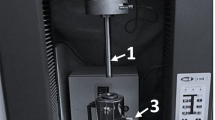The migration of the boundary layer of lubricant into a porous briquette during compacting is investigated. It is found out that the density of briquettes compacted of a mixture of iron and graphite powders with the addition of animal fat hardly increases with increasing holding under the load, while the ejection pressure increases substantially. It is assumed that the ejection pressure increases due to the infiltration of a lubricant (from the layer between briquette and die wall) into the pores of the briquette. This leads to thinning disrupting the continuity of the lubrication layer and, accordingly, to increasing the external contact friction. The conducted studies allow not only predicting the behavior of viscous lubricants, but also enhancing the possibilities of impregnating the briquettes sintered under high pressure in the die in vacuum.



Similar content being viewed by others
References
G. G. Serdyuk and L. I. Svistun, Technology of Powder Metallurgy. Part I. Powders [in Russian], Handbook: in 3 volumes, Kuban, Gos. Tekhnol. Inst., Krasnodar (2005), p. 240.
H. Rodrigues, S. Madill, M. Folliard, and T. Liu, Optimizing Compacting Lubricant Selection—a Comparison Study of Various Commercially Available Lubricants, in: Proc. 2008 World Congress on Powder Metallurgy & Particulate Materials (8–12 June 2008, Washington), Washington (2008), pp. 71–79.
I. M. Fedorchenko and R. A. Andrievskii, Basics of Powder Metallurgy [in Russian], Izdat. AN UkrSSR, (1961), p. 420.
W. Jandeska, Powder Metallurgy Lubrication Study: Lubricant Practice and Tool Coating Effects, in: Center for Powder Metallurgy Technology (August 5, 2011, Quebec), Quebec (2011), pp. 11–15.
R. D. O’Brien, Fats and Oils. Formulating and Processing for Applications [Russian translation]. Professiya, Saint-Petersburg (2007), p. 752.
E. I. Isachenkov, Contact Friction and Lubricants in Metal Forming Process [in Russian], Mashinoctroyeniye, Moscow (1978), p. 208.
V. D. Zozulya, Lubricants for Sintered Self-Lubricated Bearings [in Russian], Nauk. Dumka, Kyiv (1976), p. 192.
I. M. Fedorchenko and L. I. Pugina, Composite Sintered Antifriction Materials [in Russian], Nauk. Dumka, Kyiv (1980), p. 404.
N. Solimanjad and M. Larsson, Tribological Properties of Lubricants Used in PM Process, in: Proc. Euro PM 2005 (October 4, 2005, Prague), Prague (2005), pp. 123–133.
V. N. Kokorin, A. I. Rudskoi, V. I. Filimonov, et al., Theory and Practice of Pressing Iron-Based Heterogeneous Wetted Mechanical Mixtures [in Russian], Gos. Tekh. Inst., Ulyanovsk (2012), p. 236.
Acknowledgements
The authors are grateful to L. A. Sosnovskii for his input in conducting this study and discussing the results.
Author information
Authors and Affiliations
Corresponding author
Additional information
Translated from Poroshkovaya Metallurgiya, Vol. 55, Nos. 11–12 (512), pp. 11–15, 2016.
Rights and permissions
About this article
Cite this article
Minitskii, A.V., Loboda, P.I. The Infiltration of Lubricants into a Porous Briquette, When Compacting. Powder Metall Met Ceram 55, 640–643 (2017). https://doi.org/10.1007/s11106-017-9850-3
Received:
Published:
Issue Date:
DOI: https://doi.org/10.1007/s11106-017-9850-3




